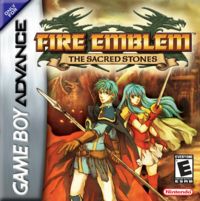Fire Emblem: The Sacred Stones

| |
| Fire Emblem: The Sacred Stones | |
| Developer | Intelligent Systems |
| Publisher | Nintendo |
| System | Game Boy Advance, Virtual Console (3DS, Wii U) |
| Release Date | Game Boy Advance JP October 7, 2004 US May 23, 2005 EU November 4, 2005 3DS Virtual Console December 15/16, 2011 (Ambassador) Wii U Virtual Console JP August 6, 2014 EU January 1, 2015 US June 18, 2015 |
| Gallery | GH Gallery |
| Rating | ESRB: E |
Fire Emblem: The Sacred Stones (known in Japan as Fire Emblem: Seima no Kouseki) is the eighth game in the Fire Emblem series and the last on the Game Boy Advance. It is the second Fire Emblem game to be released outside Japan and thus the first to actually have a subtitle.
Story[edit]
In 803 of the year of the Stone, the Grado empire invaded their long-standing ally, Renais. The attack takes them completely off guard and King Fado of Renais is unable to mount a resistance. His son, Ephraim, is still fighting Grado and only his daughter Eirika remains. In order to keep the Grado Emperor from obtaining the power of Renais, Eirika is sent from the castle with a special bracelet under the protection of Seth.
Eirika escapes and gathers companions to help her fight, eventually meeting up with Prince Ephraim.
After banding together for a time, the two separate, allowing the player to choose which royal sibling to follow for the remainder of the journey.
- Eirika's Quest - Eirika is sent to warn Rausten of the war. This takes her through the Republic of Carcino, the only nation without ties to the Sacred Stones. She meets up with Prince Innes, Gerik, and Tethys on her route, and eventually arriving in Jehanna where her surrounded troops are rescued by Ephraim's arrival.
- Ephraim's Quest - Ephraim presses on into Grado where in Fort Rigwald he rescues Princess Tana. Later he meets up with Duessel, a Grado general who trained Ephraim in combat and turned against the Grado Emperor. When he hears his sister is to be ambushed, he rescues her in Jehanna.
Gameplay[edit]
The gameplay follows a similar model of the previous Game Boy Advance titles. Characters are moved along a grid where there movement has certain unit-specific limitations. Strategy plays a large role in the game, especially since if characters die, they cannot be brought back. This provides a certain incentive for gamers to repeatedly play levels so they don't lose characters.
New additions to the game are the ability to choose alternate unit upgrades. Every unit, save for the two Lords, can choose one of two different units to upgrade to upon finding the necessary item. Another addition is the Tier 1 Units, such as the 'Journeyman' who can choose one of two Tier 2 classes, then later a Tier 3 class which gives these characters a larger variety of paths to choose than in previous games.
Legacy[edit]
No other game has been made set in the continuity of The Sacred Stones, making it the only standalone Fire Emblem game in the entire series.
Ports and Remakes[edit]
- In 2011, The Sacred Stones was included in the set of Game Boy Advance games that were released for free download on the 3DS to those participating in the Ambassador Program. It did not receive a normal eshop release. Instead, in 2014/2015, it was released for regular download on the Wii U as part of the the Wii U Virtual Console.
Sequels[edit]
Fire Emblem: Path of Radiance on the GameCube was the next game to be released and returned the series to console releases.
See Also[edit]
| Titles in the Fire Emblem Series |
|---|
| Shadow Dragon & The Blade of Light (DS) - Gaiden (Echoes) - Monshou no Nazo (DS) - Seisen no Keifu - Thracia 766 Fuuin no Tsurugi - Fire Emblem - The Sacred Stones - Path of Radiance - Radiant Dawn Awakening - Fates - Three Houses - Engage Tokyo Mirage Sessions #FE - Heroes - Warriors (Three Hopes) |